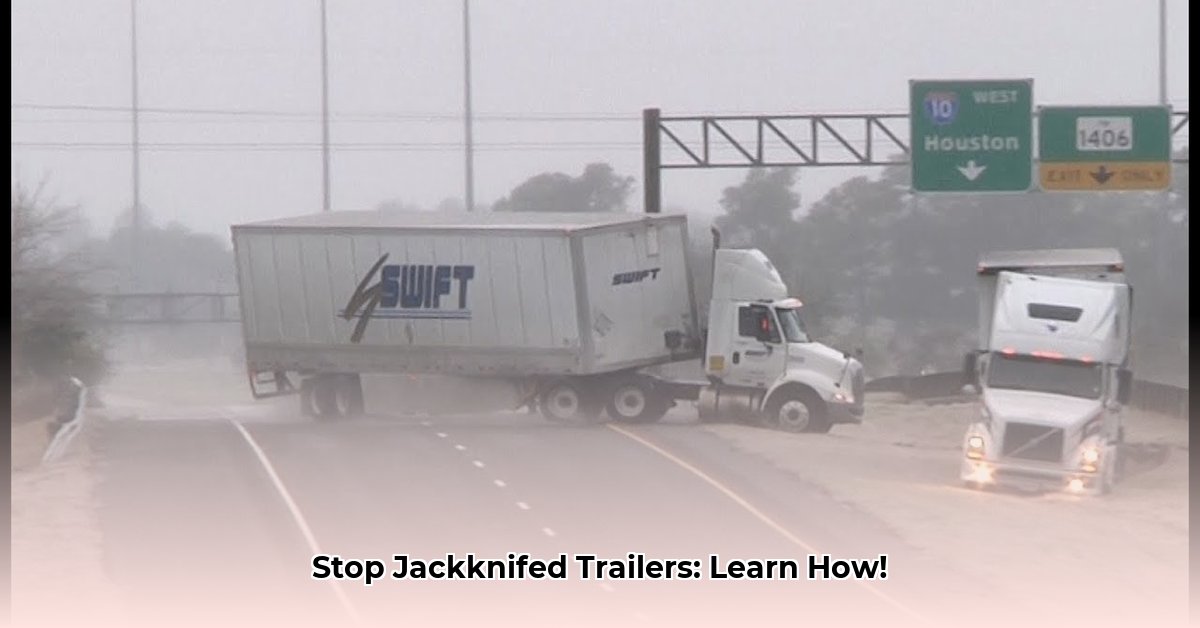
Understanding Jackknifing: Causes and Consequences
Jackknifing, the dangerous event where a tractor-trailer's trailer sharply folds against the cab, is a significant safety concern. These accidents result in injuries, fatalities, and substantial economic losses. While a single cause rarely exists, a combination of factors often contributes to a jackknifing incident. Understanding these contributing elements is the first step towards effective prevention. For more information on financing options for tractor trailers, check out this loan calculator.
Causes of Jackknifing: A Complex Interplay
Several factors can contribute to a jackknife accident. These often interrelate, creating a dangerous chain reaction. Key contributors include:
Human Error: Driver mistakes such as speeding, tailgating, and improper braking are major factors. Fatigue, distraction, or inattention can exacerbate these risks. A momentary lapse in judgment can have catastrophic consequences on slick roads.
Adverse Weather Conditions: Rain, snow, ice significantly reduce road traction, increasing stopping distances. Strong winds can further destabilize the vehicle. The increased stopping distance for a heavy vehicle in poor weather is a key contributing factor.
Cargo Issues: Improperly secured loads shift during braking or turning, altering the truck's weight distribution and increasing instability. Thousands of pounds shifting unexpectedly during a maneuver significantly increases the likelihood of a jackknife.
Consequences of Jackknifing: Human, Economic, and Legal Ramifications
Jackknifing incidents have far-reaching consequences:
Human Cost: Serious injuries and fatalities are common. The sheer size and weight of a tractor-trailer make collisions devastating. The human toll includes not only the drivers involved but also other motorists and pedestrians.
Economic Impact: Accidents cause significant property damage, delays, and lost productivity. Repair costs, cargo loss, legal fees, and the disruption of supply chains all contribute to substantial financial losses.
Legal Liability: Determining fault and liability can be complex and lead to extended legal proceedings. The legal ramifications can impact drivers, trucking companies, and shippers.
Prevention Strategies: A Multi-Stakeholder Approach
Preventing jackknifing requires a comprehensive, multi-faceted approach involving trucking companies, drivers, and regulators.
For Trucking Companies: Investing in Safety and Training
Invest in Advanced Safety Technologies: Implement anti-lock brakes (ABS) (prevents wheel lockup during braking), electronic stability control (ESC) (helps maintain vehicle stability during turns and skids), and telematics systems (monitors driving habits and vehicle performance). These technologies significantly enhance safety but are not foolproof.
Comprehensive Driver Training: Provide ongoing and thorough driver training that focuses on defensive driving techniques, hazard recognition, emergency responses, and the effective use of advanced safety systems. Simulator training is a valuable tool.
Rigorous Vehicle Maintenance: Establish and strictly enforce regular vehicle inspections and maintenance schedules to ensure all systems (brakes, tires, steering) are in optimal working condition. Proactive maintenance prevents mechanical failures that could contribute to accidents.
For Drivers: Personal Responsibility and Safe Driving Practices
Maintain Safe Following Distances: Allow ample stopping distance, especially in adverse conditions or when carrying heavy loads. Remember that a heavy vehicle requires considerably more space to stop than a car.
Adjust Speed to Conditions: Reduce speed substantially in inclement weather, on slick surfaces, or when encountering challenging road conditions. Maintaining responsible speed in all driving conditions is key.
Prioritize Rest and Avoid Fatigue: Never operate a vehicle when tired. Plan regular breaks and ensure sufficient rest to maintain alertness and optimal reaction time. Fatigue significantly impairs judgment and reaction speed.
Proper Cargo Securing: Always secure cargo correctly and in accordance with regulations. Improper loading is a significant contributor to instability and jackknifing.
For Regulators: Strengthening Enforcement and Infrastructure
Strengthen Enforcement: Rigorously enforce existing safety regulations, including hours-of-service rules and driver qualifications. Regular inspections and monitoring help ensure compliance and improve accountability.
Infrastructure Improvements: Invest in improving road infrastructure, particularly in areas vulnerable to severe weather. Improvements such as enhanced drainage, improved signage, and road design modifications can significantly reduce risk.
Data-Driven Solutions: Analyze accident data to pinpoint high-risk areas and develop targeted prevention strategies. Data-based solutions lead to more effective accident mitigation strategies.
Technology's Role: Enhancing Safety, Not Replacing Responsibility
Technology plays a vital role in enhancing safety, but it is not a standalone solution.
| Technology | Advantages | Limitations |
|---|---|---|
| ABS | Prevents wheel lockup during braking, improving control. | Doesn't eliminate jackknifing risk entirely. |
| ESC | Enhances stability and reduces rollover risk. | System malfunctions are possible; driver training still essential. |
| Telematics Systems | Monitors driver behavior and vehicle performance. | Requires driver adherence; data privacy considerations exist. |
It's crucial that drivers understand the limitations of these technologies and continue practicing safe driving habits.
Conclusion: A Collaborative Effort for Safer Roads
Preventing jackknifing demands a unified effort from all stakeholders. Trucking companies must prioritize safety, drivers need to adhere to best practices, and regulators must provide robust enforcement and infrastructure support. Through collaboration and ongoing commitment, we can make our roads significantly safer. Continuous research and development in safety technologies will further improve safety measures.